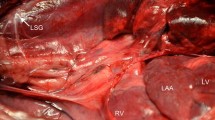Abstract
In order to further elucidate the regulatory function of canine epicardial neurons, the effects of transient coronary artery occlusion on their spontaneous activity was studied. Fifty-eight individual, spontaneously active units were identified by means of their action potential configurations in specific loci of atrial and ventricular epicardial fat of 10 anesthetized dogs. The activity of 49 of the units was modified by one minute of coronary artery occlusion. Twenty-four of the 49 responding units exhibited increased activity and 37 decreased activity during coronary artery occlusions. Activity changes were sometimes, but not always, associated with decreased left ventricular intramyocardial systolic pressure. During reperfusion, the activity of 6 units was increased compared to control levels, even though ventricular pressures remained the same. Following acute decentralization, 48% of previously active units generated spontaneous activity; the activity of 89% of these was altered during coronary artery occlusion despite the fact that overall cardiodynamics were unchanged. Following hexamethonium administration, the activity generated by 9 of 10 spontaneously active units was modified by coronary artery occlusion. It is concluded that transient coronary artery occlusion can modify the activity generated by intrinsic cardiac neurons, such modification involving central and peripheral neuronal interactions.
Similar content being viewed by others
References
Ardell, J.L., & Randall, W.C. (1986). Selective vagal innervation of sinoatrial and atrioventricular nodes in canine heart.American Journal of Physiology, 251 (Heart Circ. Physiol. 20), H764-H773.
Ardell, J.L., Butler, C.K., Smith, F.M., Hopkins, D.A., & Armour, J.A. (1991). Activity ofin vivo arterial and ventricular neurons in chronically decentralized canine hearts.American Journal of Physiology, 260 (Heart Circ. Physiol. 29), H713-H721.
Armour, J.A. (1977). Thoracic cardiovascular afferent nerves. In W.C. Randall (Ed),Neural regulation of the heart. New York: Oxford University Press, pp. 133–156.
Armour, J.A. (1985). Activity ofin situ middle cervical ganglion neurons in dogs, using extracellular recording techniques.Canadian Journal of Physiology & Pharmacology, 63, 704–716.
Armour, J.A. (1991). Anatomy and function of the intrathoracic neurons regulating the mammalian heart. In I.H. Zucker, J.P. Gilmore (Eds),Reflex control of the circulation. Boca Raton: CRC Press, pp. 1–37.
Armour, J.A., & Hopkins, D.A. (1990a). Activity ofin situ canine left atrial ganglion neurons.American Journal of Physiology, 259 (Heart Circ. Physiol. 27), H1207-H1215.
Armour, J.A., & Hopkins, D.A. (1990b). Activity ofin vivo canine ventricular neurons.American Journal of Physiology, 258 (Heart Cir. Physiol. 27), H320-H336.
Armour, J.A., & Janes, R.D. (1988). Neuronal activity recorded extracellularly fromin situ canine mediastinal ganglia.Canadian Journal of Physiology & Pharmacology, 66, 119–127.
Armour, J.A., Yuan, B., & Butler, C.K. (1990). Cardiac responses elicited by peptides administered to canine intrinsic cardiac neurons.Peptides, 11, 753–761.
Blair, R.W., Ammons, W.S., & Foreman, R.D. (1984). Responses of thoracic spinothalamic and spinoreticular cells to coronary artery occlusion.Journal of Neurophysiology, 51, 636–648.
Bloomquist, T.M., Priola, D.V., & Romero, A.M. (1987). Source of intrinsic innervation of canine ventricles: A functional study.American Journal of Physiology, 252 (Heart Circ. Physiol. 21), H638-H644.
Brown, A.M. (1966). Excitation of afferent cardiac sympathetic nerve fibers during myocardial ischemia.Journal of Physiology, (London), 190, 35–53.
Cerati, D., & Schwartz, P.J. (1991). Single cardiac vagal fiber activity, acute myocardial ischemia, and risk for sudden death.Circulation Research, 69, 1389–1401.
Foreman, R.D., & Ohata, C.A. (1980). Effects of coronary artery occlusion on thoracic spinal neurons receiving viscerosomatic inputs.American Journal of Physiology, 238 (Heart Circ. Physiol. 7), H667-H674.
Gagliardi, M., Randall, W.C., Beiger, D., Wurster, R.D., Hopkins, D.A., & Armour, J.A. (1988). Activity ofin vivo canine cardiac plexus neurons.American Journal of Physiology, 255 (Heart Circ. Physiol. 24), H789-H800.
James, T.N. (1962). Anatomy of the sinus node of the dog.Anatomical Record, 143, 251–254.
Malliani, A. (1982). Cardiovascular sympathetic afferent fibers.Reviews of Physiology, Biochemistry & Pharmacology, 94, 11–74.
Malliani. A., & Lombardi, F. (1978). Neuronal reflexes associated with myocardial ischemia. Cardiovascular sympathetic afferent fibers. In P.J. Schwartz, A.M. Brown, A. Malliani, & A. Zanchetti (Eds),Neural mechanisms in cardiac arrhythmias. New York: Raven Press, pp. 209–219.
Minisi, A.J., & Thames, M.D. (1991). Reflexes from ventricular receptors with vagal afferents. In I.H. Zucker, J.P. Gilmore (Eds),Reflex control of the circulation. Boca Raton: CRC Press, pp. 381–387.
Recordati, G., Schwartz, P.J., Pagani, M., & Malliani, A. (1971). Activation of cardiac vagal receptors during myocardial ischemia.Experientia, 27, 1423–1424.
Seabrook, G.R., Fieber, L.A., & Adams, D.A. (1990). Neurotransmission in neonatal rat cardiac ganglionin situ.American Journal of Physiology, 259 (Heart Circ. Physiol. 28), H997-H1005.
Smith, F.M., Hopkins, D.A., & Armour, J.A. (1992). Electrophysiological properties ofin vitro intrinsic cardiac neurons in the pig (Sus scrofa).Brain Research Bulletin, 28, 715–725.
Thorén, P.N. (1977). Characteristics of left ventricular receptors with nonmedullated vagal afferents in cats.Circulation Research, 40, 415–421.
Thorén, P.N. (1978). Vagal depressor reflexes elicited by left ventricular C- fibers during myocardial ischemia in cats, In P.J. Schwartz, A.M. Brown, A. Malliani, & A. Zanchetti (Eds),Neural mechanisms in cardiac arrhythmias. New York: Raven Press, pp. 179–190.
Uchida, Y., & Murao, S. (1974). Excitation of afferent cardiac sympathetic nerve fibers during coronary occlusion.American Journal of Physiology, 226, 1094–1099.
Wood, J.D. (1991). Communication between minibrain in gut and enteric immune system.News in Physiological Sciences, 6, 64–69.
Author information
Authors and Affiliations
Additional information
This work is supported by the Medical Research Council of Canada (MT-10122), the Nova Scotia Heart and Stroke Foundation, and the American Heart Association.
Rights and permissions
About this article
Cite this article
Huang, MH., Ardell, J.L., Hanna, B.D. et al. Effects of transient coronary artery occlusion on canine intrinsic cardiac neuronal activity. Integrative Physiological and Behavioral Science 28, 5–21 (1993). https://doi.org/10.1007/BF02691196
Issue Date:
DOI: https://doi.org/10.1007/BF02691196



